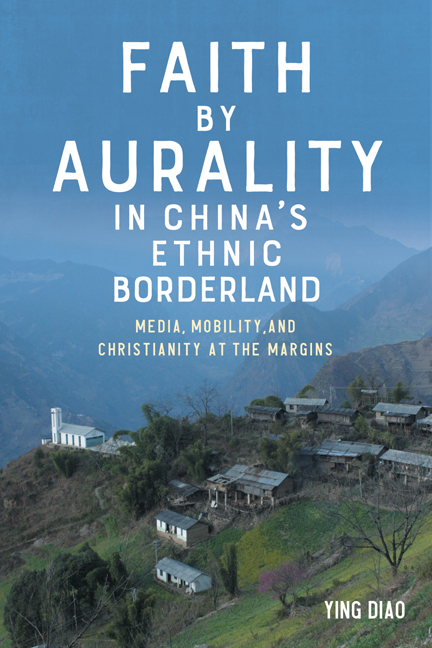Book contents
- Frontmatter
- Dedication
- Contents
- Acknowledgments
- Notes on Romanization and Terminology
- Introduction
- 1 Becoming the Faithful: Cleanliness and Conversion
- 2 Hearing the Return of Faith: Radio and Listening Audience
- 3 Producing Gospel Songs: Studio and Media Practitioners
- 4 Faces and Places: Sounds That Recognize
- 5 Traces of Faith: Sound Artifacts and Infrastructures
- 6 Performing Recorded Songs: Religiosity by Body
- 7 Hidden Faith: Sanitizing the Voice
- Conclusion: Faith on the New Frontier
- Appendix 1 Glossary of Old Lisu
- Appendix 2 Glossary of Chinese Characters
- References
- Index
5 - Traces of Faith: Sound Artifacts and Infrastructures
Published online by Cambridge University Press: 15 May 2024
- Frontmatter
- Dedication
- Contents
- Acknowledgments
- Notes on Romanization and Terminology
- Introduction
- 1 Becoming the Faithful: Cleanliness and Conversion
- 2 Hearing the Return of Faith: Radio and Listening Audience
- 3 Producing Gospel Songs: Studio and Media Practitioners
- 4 Faces and Places: Sounds That Recognize
- 5 Traces of Faith: Sound Artifacts and Infrastructures
- 6 Performing Recorded Songs: Religiosity by Body
- 7 Hidden Faith: Sanitizing the Voice
- Conclusion: Faith on the New Frontier
- Appendix 1 Glossary of Old Lisu
- Appendix 2 Glossary of Chinese Characters
- References
- Index
Summary
We are planning to make these new gospel songs and dances available in VCD and DVD video formats. In this way we can reach as many young people as possible by means of distributing the videos. We are planning to start very soon.
—Lazarus Fish, MACM Newsletter, May 2005Everything has moved onto WeChat now. It is very convenient. Every church has a WeChat group. The group leader makes announcements in the group and people discuss issues in the group as well.
—Pastor Jesse, WeChat message to author, March 24, 2020This chapter looks into the circulation of Lisu gospel music through the “disc recording”—both VCDs (Video Compact Discs) and what is now commonly used, DVDs (Digital Video Discs)—which finds its parallel with several other minor recording industries in different parts of China's border regions: whether the cross-border trade in cassettes of Dai pop songs in Xishuangbanna in the 1990s (Davis 2005); the flows of Uyghur pop between the Uyghurs in Xinjiang and those in Turkey, the Central Asian states, and the exile community in the United States (Harris 2005, 2012); or the influence of Inner Mongolian pop music outside China (Baranovitch 2001). They share many similar features, including a relatively short history, the emergence of private studio production, the facilitation of technological progress, and the role of individual musicians’ appeal in the cross-border success.2 Regardless of all these similarities, the development of these minor recording industries differs from each other in terms of degrees of state control, impetus for music production, musical styles, and width of transmission (for a detailed analysis, see Diao 2015, 318–20).
In this chapter, I analyze the disc recordings’ medial qualities as a form of auditory technology and I consider the broader infrastructures that facilitate this technology's mediality and efficacy. At the end of the chapter, I turn to the mediating role of the Chinese social media, represented by WeChat. I should first clarify the reason why I chose to focus on the medium of the disc recording. Until the mid-2010s, Lisu gospel music had been distributed mainly through the exchange of physical copies rather than through online platforms, although combined usage of two publishing methods existed on smaller scales.
- Type
- Chapter
- Information
- Faith by Aurality in China's Ethnic BorderlandMedia, Mobility, and Christianity at the Margins, pp. 115 - 142Publisher: Boydell & BrewerPrint publication year: 2023

